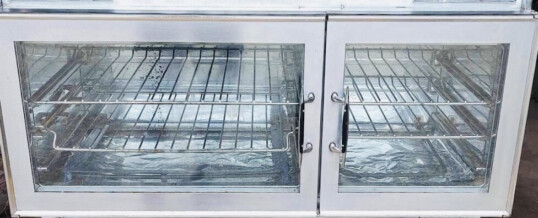
My great grandparents lived on a homestead. They cooked on a woodstove.
Most of us today have no idea how good we have it.
For my great grandparents’ generation, remodeling the kitchen meant picking a different place to stack the wood for the stove.
When I was growing up in Ashdown, Arkansas, we didn’t have air conditioning or a telephone, but we did have a step up from a woodstove. Mom had a 1950s range and oven.
I’m not sure if the gas stove my mom used came with the small, red brick house on Beech Street or if they bought it. But it got the job done.
Many a biscuit was baked in that oven. Many a sausage patty, fried potato, and cast iron skillet full of gravy were cooked on top of it.
As kids, we just took it for granted.
How man has cooked his food has remained pretty much the same since the beginning. Food over heat.
But the way that we combine heat and food has certainly become a lot fancier. Look no further than the appliance selections that exploded after the Second World War.
The country and its economy were in great shape. People had good jobs with good paychecks, and they were looking for ways to spend it.
The appliances of the 1950s and early 60s are the pinnacle of design and functionality. To this day, their Space Race look and options are quite impressive.
The Frigidaire Flair (at the time, Frigidaire was a division of General Motors) was a highly coveted cook top and oven. With its chrome, glass doors, and slide-out burners, the Flair came to prominence after being featured in Samantha’s kitchen on the TV show, Bewitched.
The Flair’s predecessor, the Tappan Fabulous 400, featured many similar features, including a built in rotisserie and a burner that shut off when you removed the pot or skillet.
America wanted bigger, fancier, and more bells and whistles. And manufacturers answered the call.
It was a race between Frigidaire, Tappan, GE, Kelvinator, Admiral, Kenmore, O’Keefe & Merritt, and Amana.
Amana was famous for the Radar Range, which was a fancy name for a microwave oven. Its origins date back to World War II when an engineer named Percy Spencer worked for a company called Raytheon.
The story goes that Spencer was working near a radar set when he noticed the chocolate bar in his pocket was melting.
What he didn’t notice was that his body was also being cooked, but he lived to help develop something that most of us now have in our homes.
What Spencer helped discover became available just a couple of years later as an appliance.
The Radar Range was huge and weighed as much as a Buick.
It was also just for rich people.
When the Amana Radar Range debuted in 1947, it was for commercial applications. The first Radar Range was six feet tall and cost around $50,000 in today’s money.
The first home version came 20 years later in 1967 with a price tag equivalent to $4,000.
In 1975, microwave ovens outsold regular ovens for the first time. But even then, a microwave cost around $1,000.
Most Americans couldn’t afford those price tags. In the 1970s, $1,000 was about the average monthly salary.
Some families went into debt to buy the nicer appliances, but most couldn’t afford them.
If you couldn’t afford the Fabulous 400, the Flair, or the Radar Range, you could always go on a game show to win them.
It was Monty Hall on Let’s Make A Deal; Bob Barker on The Price Is Right; and other daytime TV fare that gave the opportunity to not only win an oven, but also possibly an entirely new kitchen.
You just had to win.
The rest of us could watch and dream. Until recently.
I saw an ad online for a Tappan Fabulous 400. It looked to be in remarkably good shape. So I bought it.
My wife won’t let me put it in the kitchen, so I plan to put it in my man cave.
I’ll have the coolest man cave around. And I can cook a rotisserie chicken while I watch reruns of Let’s Make a Deal.
And I’ve already got the spot picked out. I’ll put it next to the wood stove. I think my great grandparents would approve.
©2024 John Moore
John’s books, Puns for Groan People and Write of Passage: A Southerner’s View of Then and Now Vol. 1 and Vol. 2, are available on his website TheCountryWriter.com, where you can also send him a message.
JAN
2024
